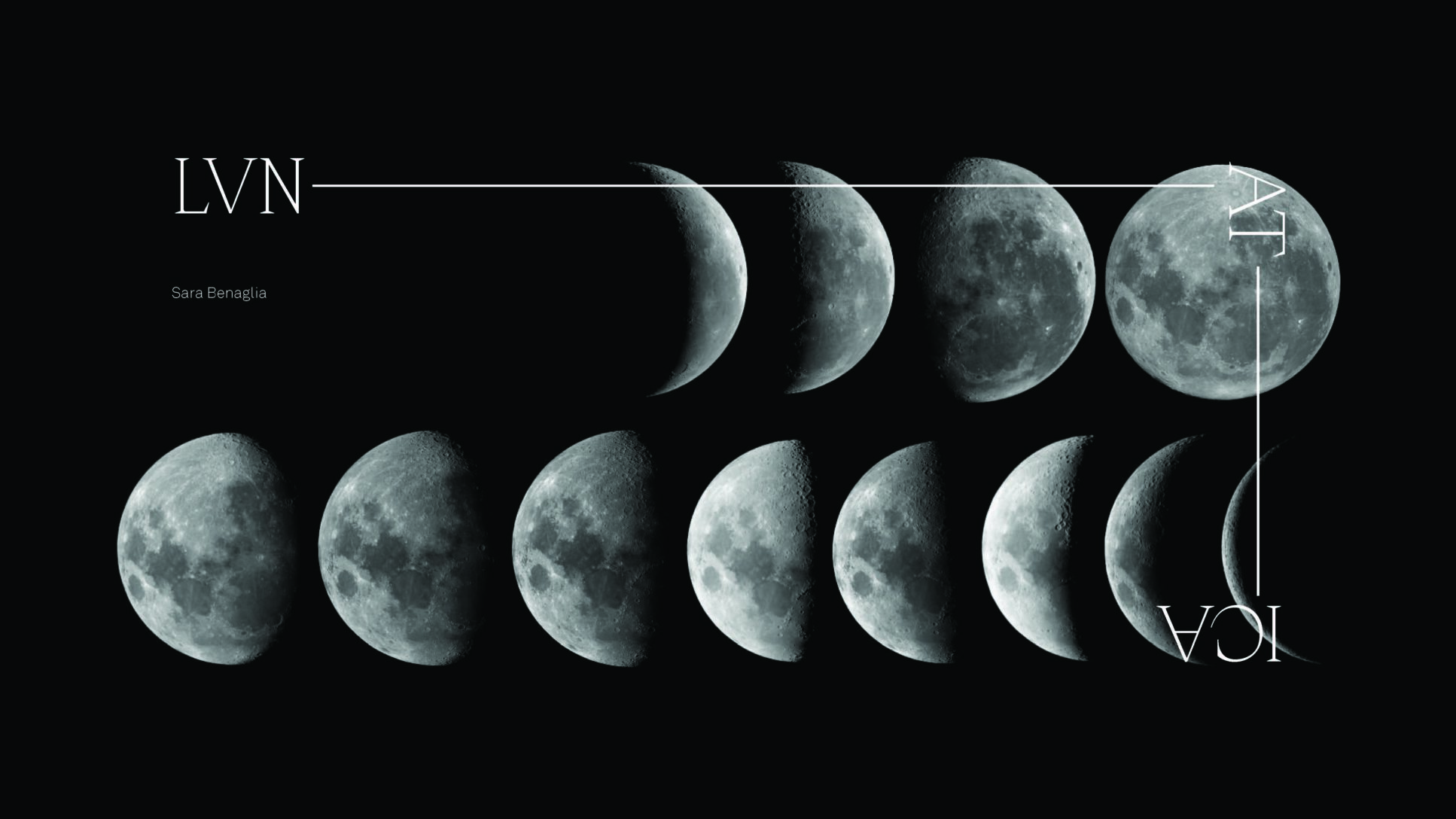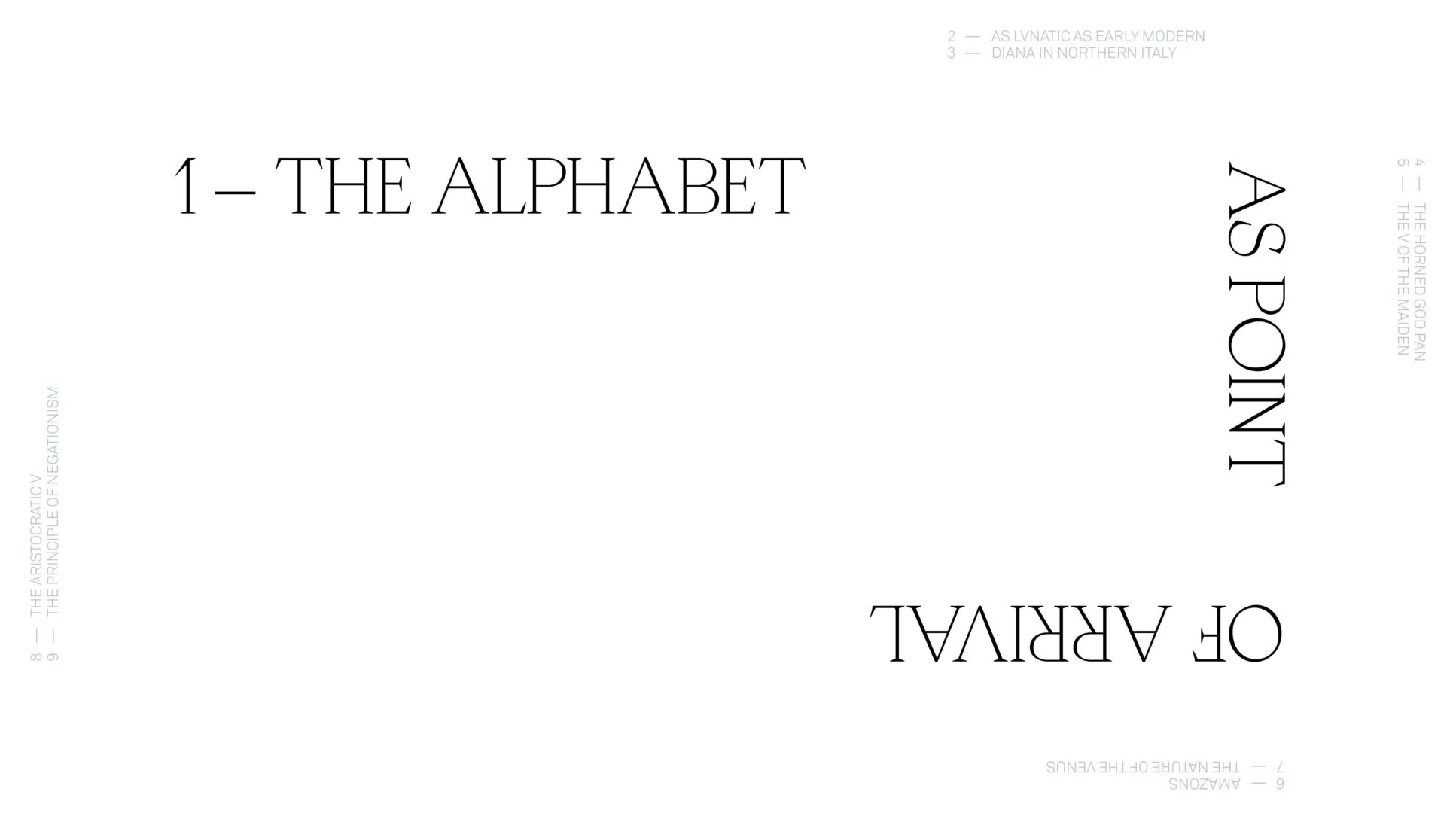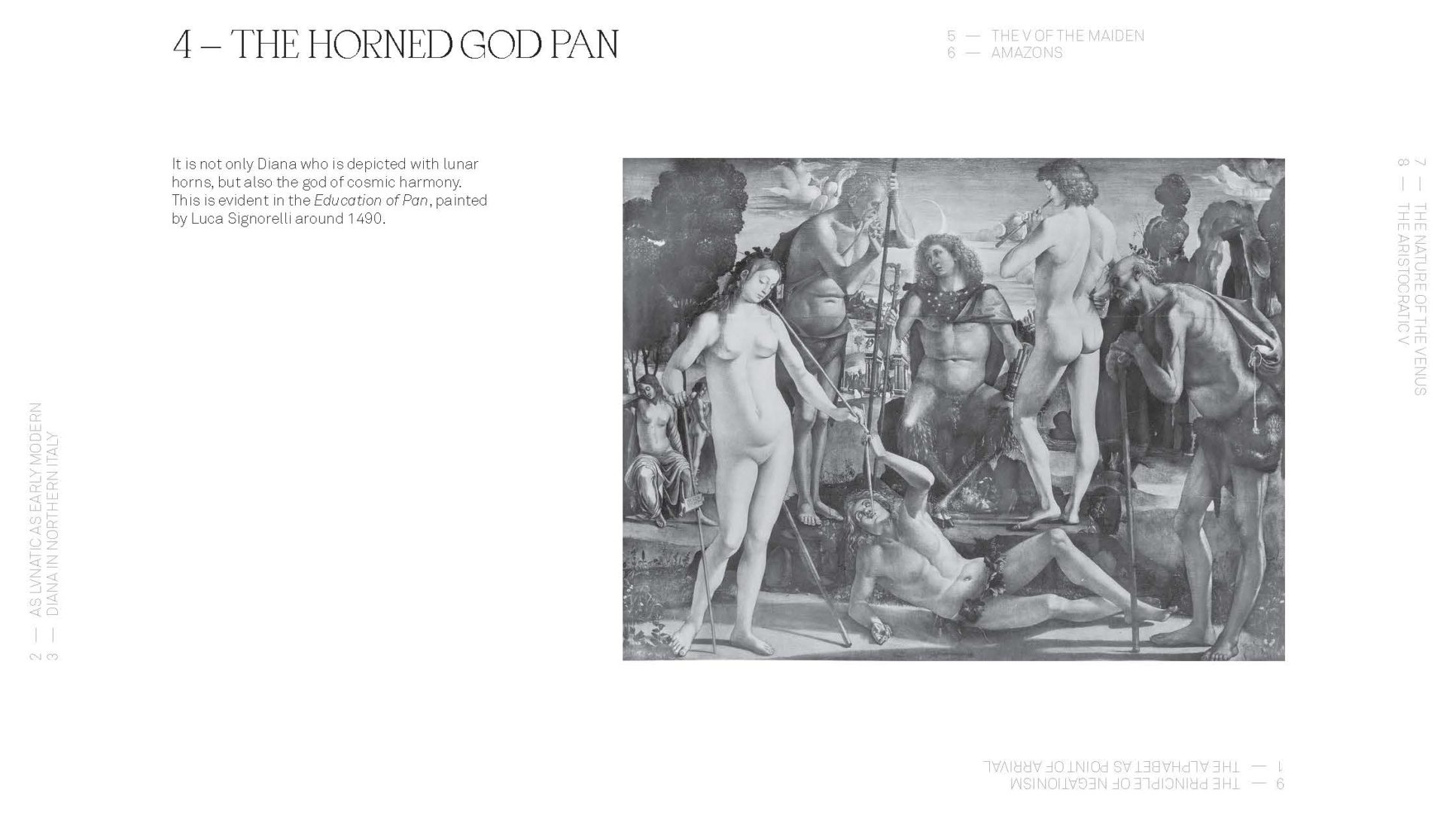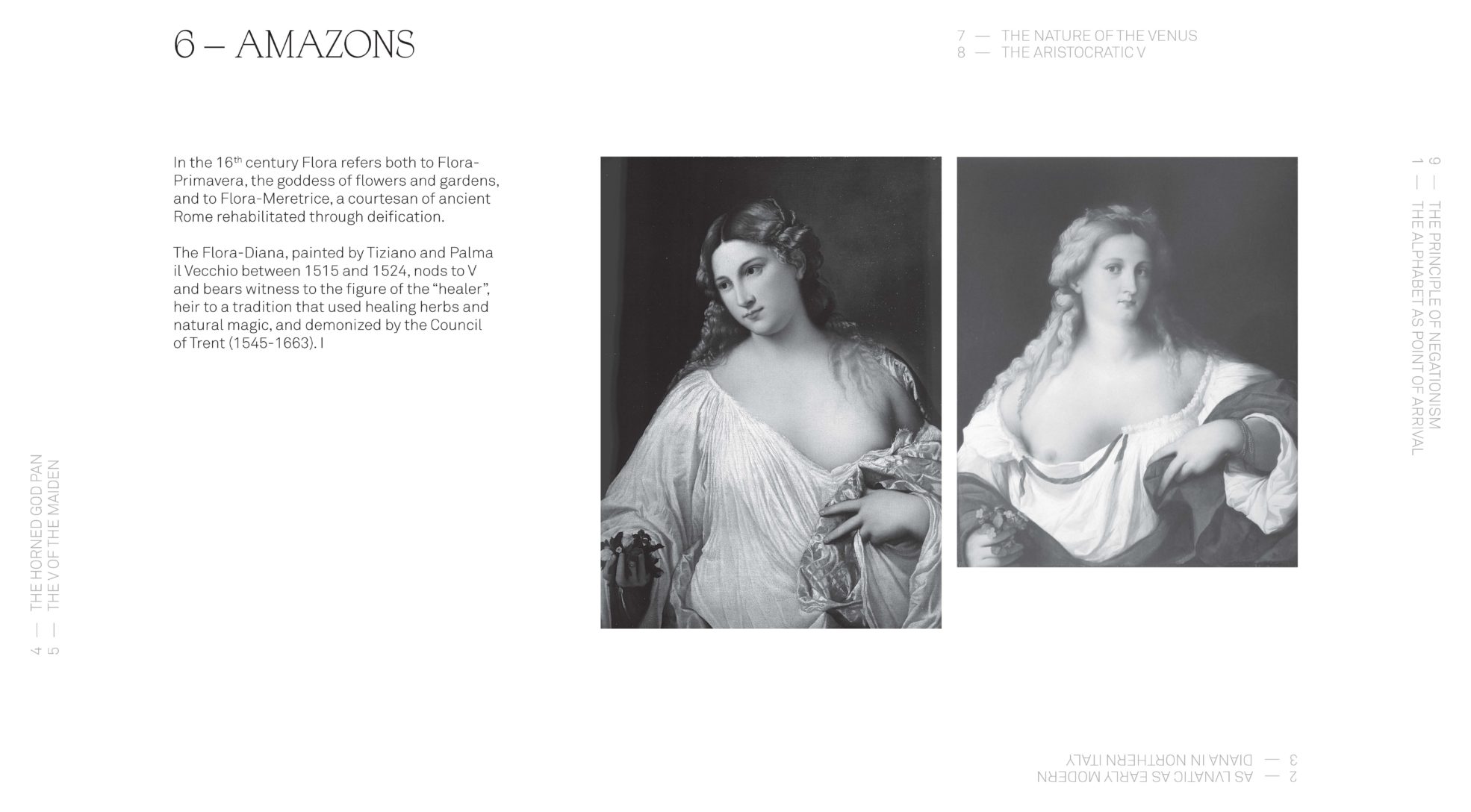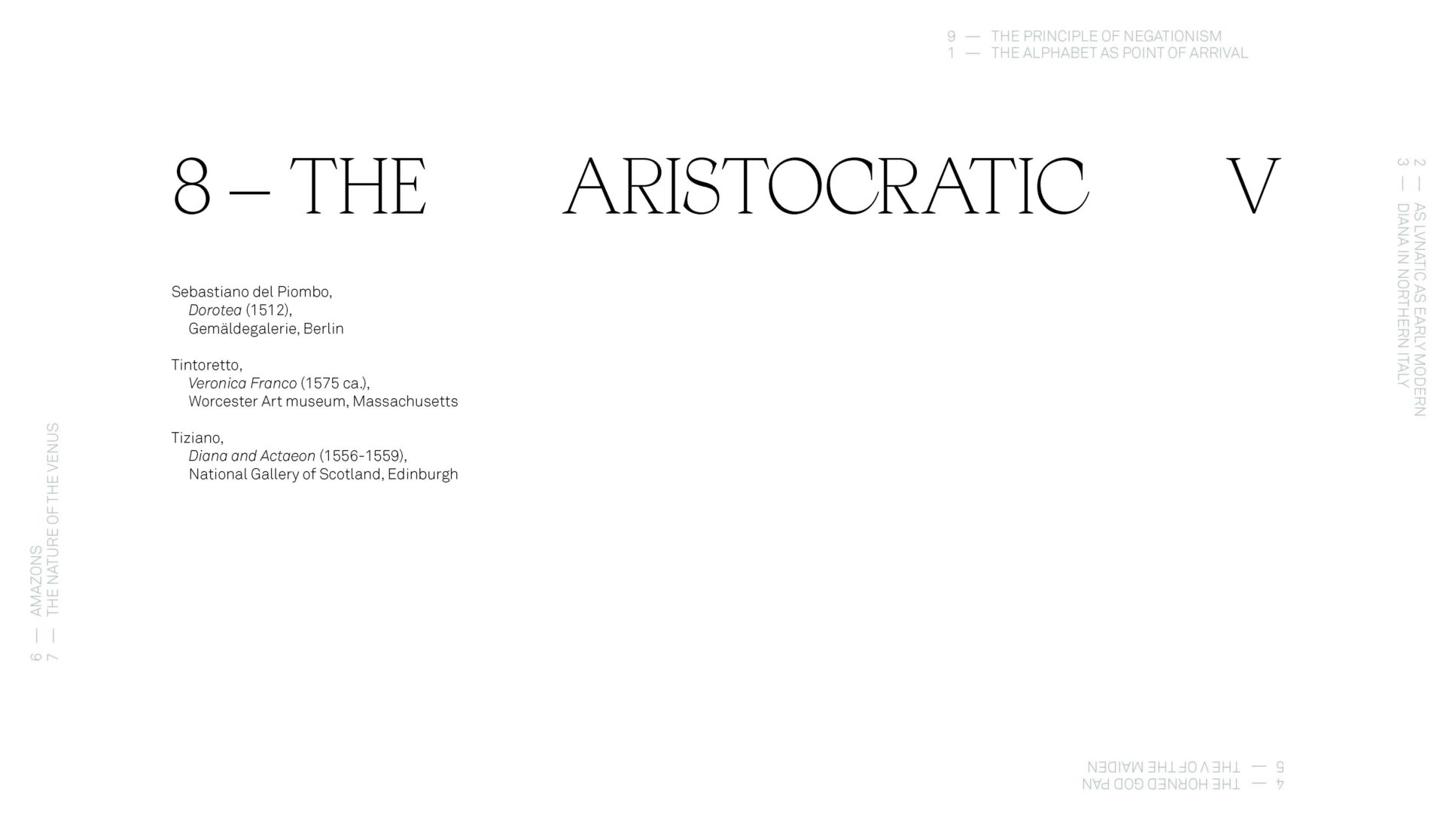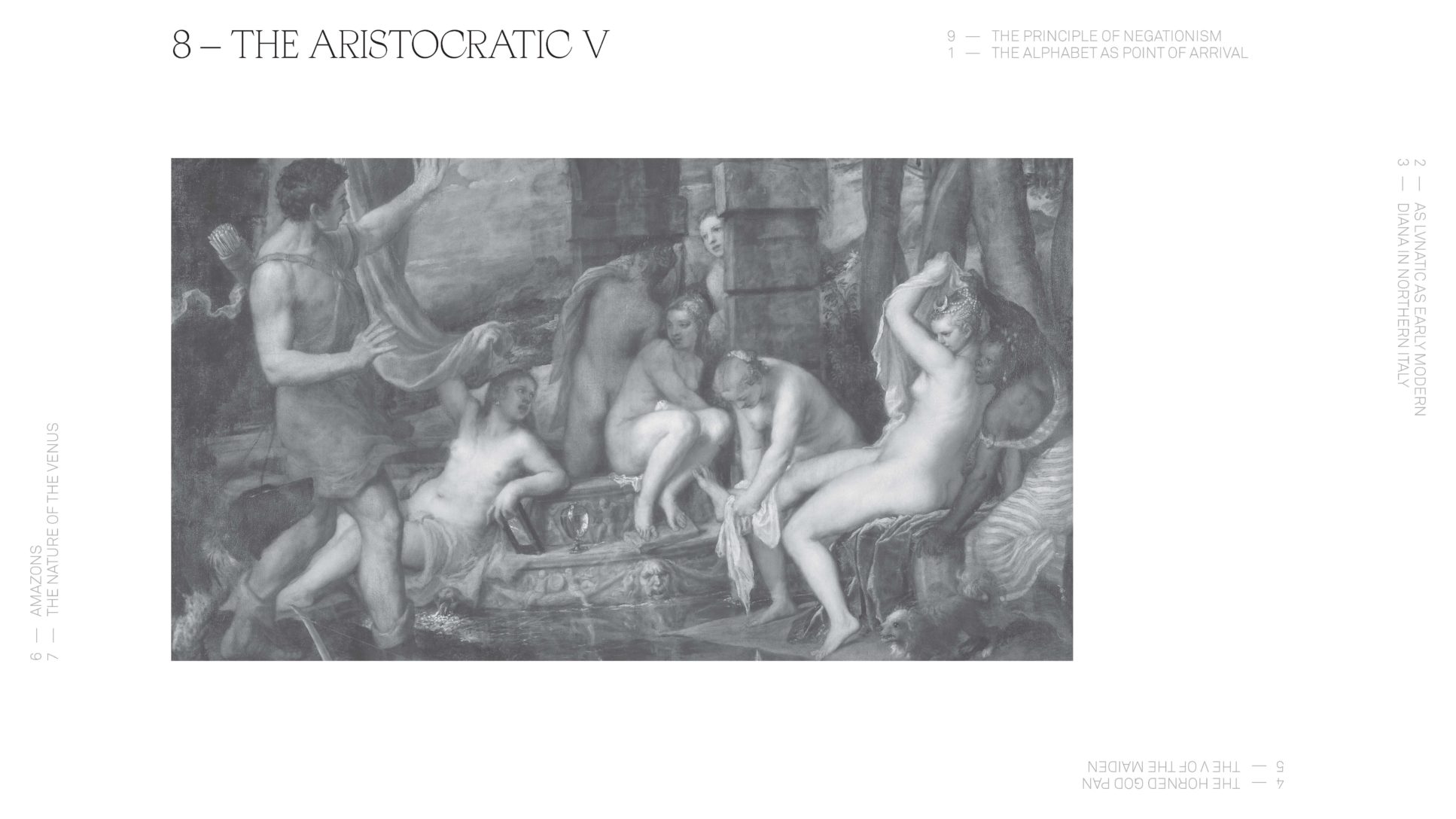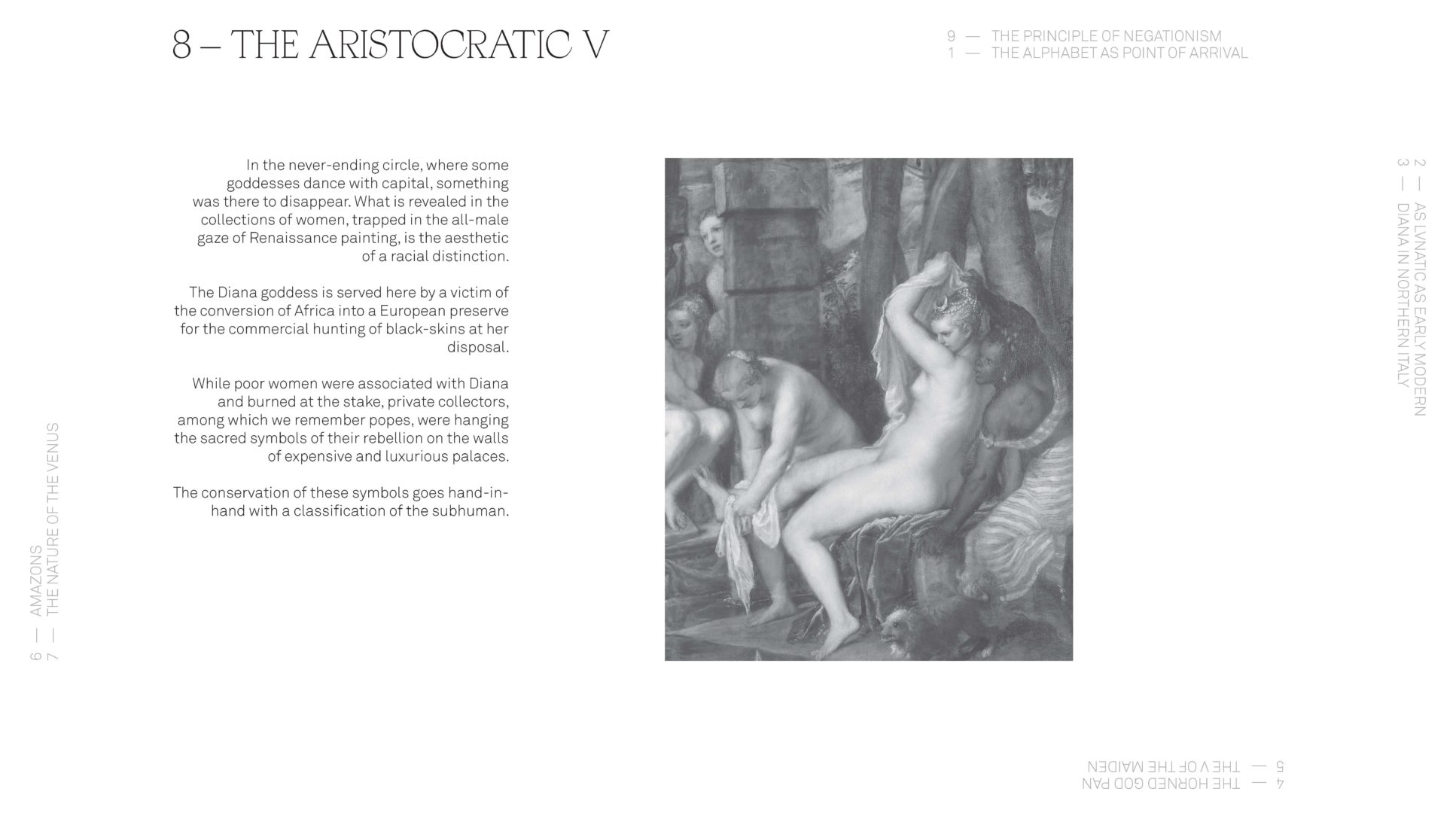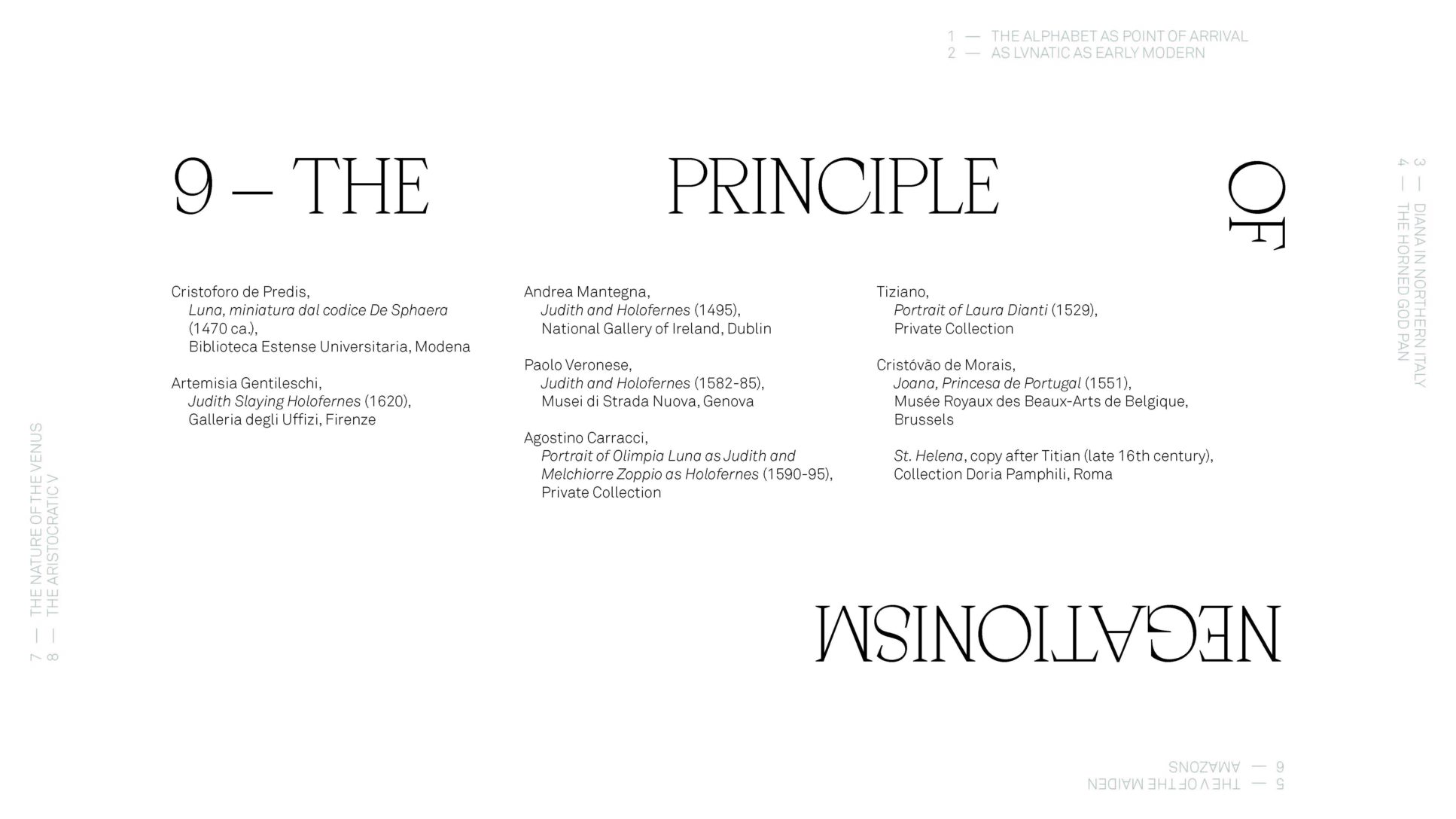Sara Benaglia, artist
LVNATICA (Research project. July 2020)
LVNATICA is a short draft of a book that I started to write few months ago. Its object of research is the interpretation of the “V” gesture in paintings realized by illustrious artist of Manerism in the territories of La Serenissima in the 16th century.
The iconographic apparatus stems form and then builds upon the text by Mauro Zanchi, Sotto il Segno di Diana. Tiziano, Palma il Vecchio e i misteri della Grande Dea (2015), but the arguments diverge from the original.
I comment on some pictures, which glorified the patriarchal history in the Venetian Renaissance. I comment on the visual hidden elements of a particular collusion.
On which fields of knowledge are you focused?
Art + feminist and de-colonial studies.
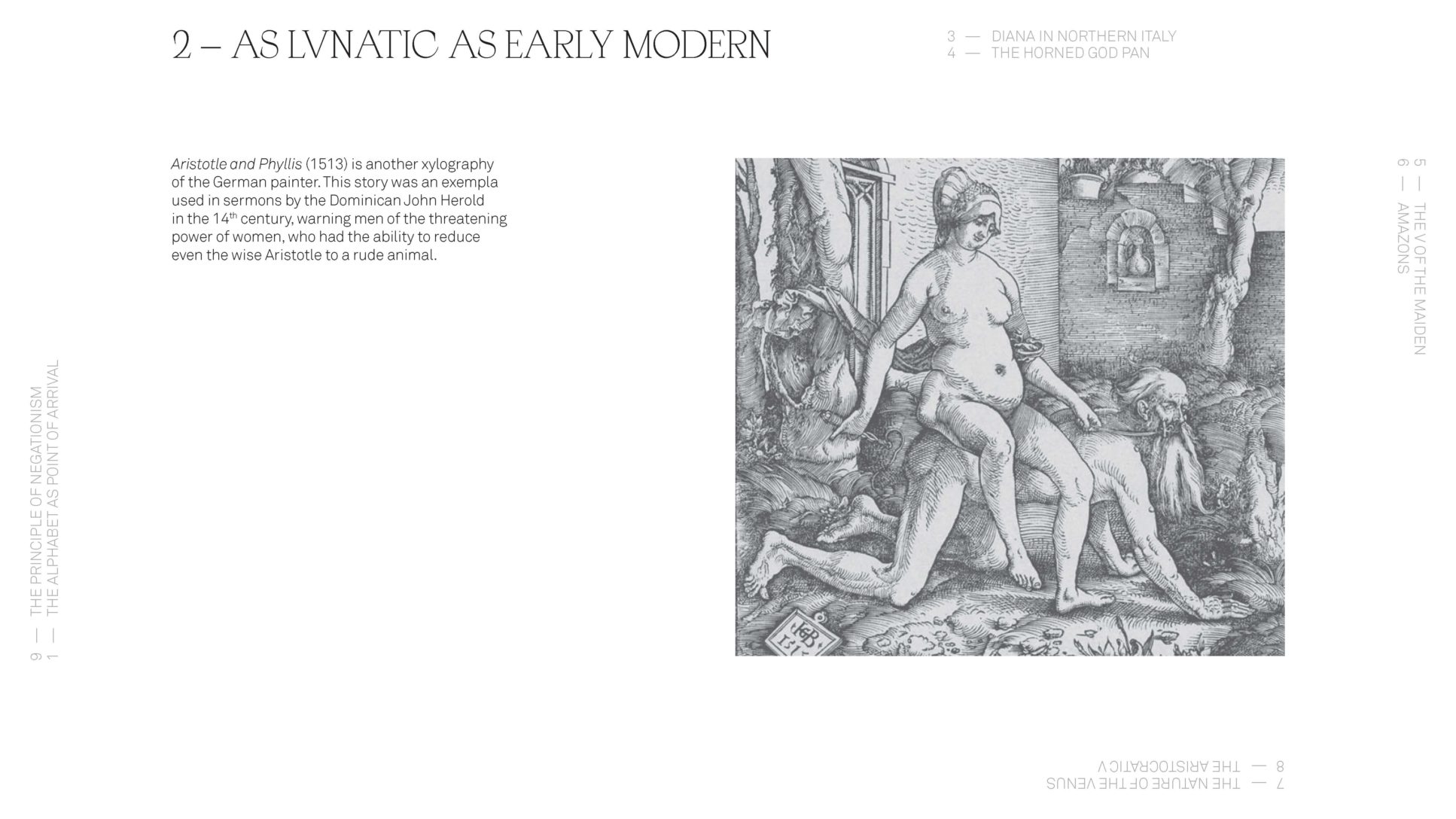
What is the object of your research?
My artistic research from 2011 to 2015 focused on the analysis of the physical exercise in relation to a spiritual (with particular reference to theosophy) and political belief (with a focus from the birth of the Società Ginnastica in Italy to the foundation of the Lega Lombarda party).
A first incipit in this research path was Carla Lonzi’s reading, Assenza della donna da momenti celebrativi della manifestazione creativa maschile (Rome: Rivolta Femminile, 1971), in which the art critic let emerge the idea of visual art as a category of historical exclusion of the feminine. Hence my bold proposal to use a physical component that would undermine visibility and create a comparison of exclusion between the Museum and the Gymnasium of ancient Greece.
In my work, the adoption of a radical position had as its ultimate goal to challenge the visual organization of artwork as part of a capitalist structure of work in which sexual difference would be part of a larger transformation project.
Femininity, as a performing activity (J.Butler), had driven me to search for what male bodies could accomplish that female bodies could not, within a context where the government of individuals takes place at the level of “nervous influences, contractions of kinesic bodies, discharges of hormonal fluids“. The gymnastic posture therefore mimicked the general domestication of women in a capitalist context but also in an educational one, since sexual discrimination in school education was eliminated only over time and thanks to feminism. On an aesthetic level the sexual gender dichotomy is so reflected in the predominance that had idealism in confining women to the material level of existence.
The following works, instead, He wanted to Be Infinite (2016) and Pink Rust (2017-2019) mark a formal passage in my work, no longer focused on the production of new images but on managing them in relation to a text. In these two projects video, photographs and drawings are organized in the form of “abstract notes”, flanked by a textual production that is a fiction in He wanted to Be Infinite and a theoretical scheme in Pink Rust. The object of production in my work is no longer a commodity, because of the implication that the exercise of the right to derive income from the control of such images determines.
My work as an artist is no longer to produce works, but rather to create situations that prescribe meaning, in a horizon in which my artistic, curatorial and theoretical practice are indistinguishable.
Could you identify some constants in your work?
The declination / adaptation of texts into images.
I like to use materials that make the work unsellable: the earth that is scattered, the photographs printed on stickers that will be torn.
My work, as well as my theoretical practice, have an iconoclastic tension, derived from being in conflict with the humanistic culture that formed me, while historically women have been excluded from it for centuries. I experience the inclusion of women in visual culture as a form of equality granted to colonized people. This does not mean that I do not respect the work of women artists or photographers with whom I happen to work. It means that I keep having this doubt in me and on me practicing.
I feel the same Kantian aesthetic category (whose relevance even in the contemporary world fills me with discouragement): aesthetic is never autonomous from politics. Art may have a political content, but it does not work in a material dimension. This maintains an open problem in the aesthetic infrastructure itself, so the museum form is a model to be unravelled, because it is incongruous.
In this sense I would say that my work is permeated by a constant desire to unravel the history of Western art, to show its inconsistencies, rather than writing the next chapter.
How did you find out about Aby Warburg’s work?
I read the Serpent Ritual years ago, and then I realized the influence of his method on the way we conceive art. Recently I was talking with a friend of mine about LVNATICA, the PDF that I’m sending you. He suggested me to take a look at Some Faggy Gestures by Henrik Olesen, where Warburg’s imaginery finds an installative and queer derivation in contemporary art.
How would you define an Atlas?
A visual logical possibility.
Atlas as a conceptual, formal and mnemonic device; do you use it in your work?
I use it as evidence of a historical process of transformation that I’m thinking/writing about.
Do you know about the existence of Mnemotechnics?
Yes, but I don’t use them.
Which mnemonic system guides the organization of your material?
The visual path in LVNATICA continues only until the moment in which theory design a new direction. In particular the works presents moments of doubts – found in specific images – towards the ideologies of language and classicism.
Language is question starting from a figurine studied by Marija Gimbutas that meet the Gutenberg Galaxy.
The reading of venetian Mannerist paintings opens a door to the voice of Carla Lonzi and the protocols designed by a male gaze for the women’s body. A specific gesture, that could be interpreted as a sign of freedom, doesn’t seem to pass the gate of classism. Black Studies give voice to the African presences in the Renaissance Venice.
The mnemonic system is a reactive system. It somehow detects an error when there is a lack of signifier coming from the institutionalized history of art.
Are there visual and emotional formulas (pathosformeln) in your project?
The method of work is also derivative (or reactionary?) of what is emotion in a couple relationship, in particular when work too is involved into it. The first edition of this work is the book Sotto il Segno di Diana written by my partner Mauro Zanchi in 2015.
I use here the iconographic apparatus of that book to design a new direction through new interpretations and a tangent iconographic path.
In LVNATICA I apply a feminist reading to some paintings of the 15th century to criticize such images that could be, or have been, considered pathosformeln but that are not, since those images in the humanitarian context seemed to be representative of the universal world, while they are actually excluding those that belong to classes, races and gender considered inferior.
The same idea of archetypical image in Aby Warburg could be questioned in this respect (see the work of Henrik Olesen that goes in this direction, for example).
In your work, do you identify formal or conceptual recurrences such as repetitions and disruption, distance and proximity, identity and migration, conflict and colonization?
In LVNATICA the repletion of a gesture is the fundamental elements on which all the work depends. The use of the zoom, of details, of blurring or proximity take the viewer to the repetition while the voice guide the eye to see a conflict. Colonization and the memory of the roman grandiosity are at the base of an history of negationism whose first step are written taking advantage of Warburg’s approach to image.
In your work, what is the balance between image and text?
The reading of images was and is always the point of departure for finding contradictory details in the history that we know.
Thinking about Warburg’s ‘good neighborhood rule’, what are the books that underpin your project?
Bono, Salvatore. Schiavi. Una storia mediterranea (XVI-XIX secolo). Bologna 2016.
Ehenreich, Barbara and Deirdre English. Le streghe siamo noi. Il ruolo della medicina nella repressione della donna. Milano 1975.
Canfora, Luciano, Ideologia del Classicismo, Torino 1980.
Federici, Silvia. Il calibano e la strega. Le donne, il corpo e l’accumulazione originaria. Sesto San Giovanni 2015.
Gimbutas, Marija. The Goddesses and Gods of Old Europe. Myths and Cult Images. London 1974.
Lonzi, Carla. Sputiamo su Hegel e altri scritti. Milano 1974.
McLuha, Marshall. La galassia Gutenberg: nascita dell’uomo tipografico. Milano 1976.
Mignolo, Walter. The Dark Side of Renaissance. Ann Arbor 1995.
Spicer, Joaneath and Natalie Zemon Davis, Kate Lowe, Ben Vinson III. Revealing the African Presence in Renaissance Europe. Baltimore 2013.
Ventrella, Rosa. Honorata cortigiana. Cagliari 2011.
Zanchi, Mauro. Sotto il Segno di Diana: Tiziano, Palma il Vecchio e i misteri della Grande Dea. Bergamo 2015.
Willis, Deborah, BLACK PORTRAITURE(S) II Conference: Imagining the Black Body and Restaging ‘Ornamental Blackness’ in History. NYU’s Villa La Pietra, Firenze, 28-31 May 2015.
Artist and researcher, with a practice based on the critique of the Visual Discipline, I am curator of the space BACO_BaseArteContemporaneaOdierna, together with Mauro Zanchi, in Bergamo (Italy) since 2016. I write essays and interviews with a focus on the relationship between art and politics, with a specialization on Italian radical feminism as a key to interpreting visual distortions. I publish my writings on ATPdiary, Doppiozero and LaBalenaBianca mostly. Among my latest publications are Metaphotography (Skinneboox, 2019); Africa in Giardino (Moretti & Vitali, 2018); Oltrerosa (Moretti & Vitali, 2018).
